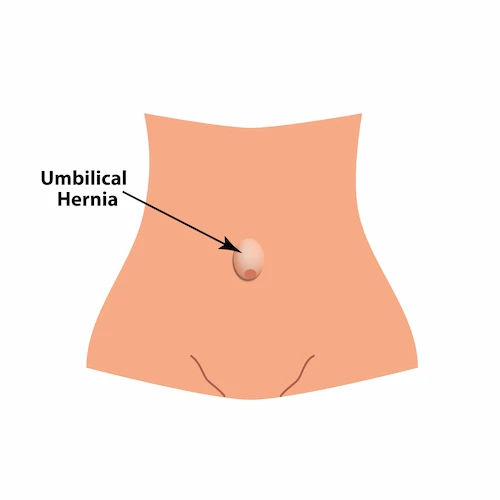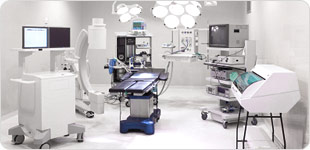Umbilical Hernia

It's not uncommon for a woman to develop an umbilical hernia during the last months of pregnancy.
The expert hernia doctors at Hernia Center Los Angeles are specialists in umbilical hernia repair and diagnosis in both children and adults.
- What is an Umbilical Hernia?
- Umbilical Hernia Causes
- Umbilical Hernia Symptoms
- Preparing for Umbilical Hernia Surgery
- Umbilical Hernia Treatment
- Recovery After Umbilical Hernia Surgery
- Frequently Asked Questions About Umbilical Hernias
What is an Umbilical Hernia?
An umbilical hernia occurs when part of the intestine or abdominal tissue protrudes through a weak spot or hole in the abdominal muscles around the belly button (umbilicus). This can create a visible bulge or swelling at the belly button. Umbilical hernias are most common in newborns.
Umbilical hernias can occur in men, women or children. The navel is a naturally weak area for the abdominal wall even in adults, since it once acted as an opening in the abdominal wall through which the umbilical cord passed. That opening normally closes just after birth. If the muscles don't join together completely in the midline of the abdomen, this weakness in the abdominal wall may cause an umbilical hernia at birth or later in life.

Umbilical Hernia Causes
Causes of Umbilical Hernias in Infants
Umbilical hernias can occur in infants, children, and adults, but they are most commonly found in babies. In infants, umbilical hernias occur when the abdominal muscles around the belly button haven't fully closed yet after birth, leaving a small opening for the intestines to push through.
Causes of Adult Umbilical Hernias
In adults, umbilical hernias can develop due to a variety of reasons. Risk factors for umbilical hernias include:
- Obesity
- Pregnancy
- Straining during childbirth
- Straining during bowel movements
- Heavy lifting
- Chronic coughing
- Previous surgeries
- Congenital weakness in the abdominal wall
- Certain medical conditions, such as ascites (excessive abdominal fluid)1
Umbilical Hernia Symptoms
The most common symptom of an umbilical hernia is a visible bulge or swelling at the belly button (or an “outie” belly button or navel), which may become more prominent when standing or straining. The protrusion may be soft or firm to the touch, and it may be accompanied by abdominal pressure or abdominal pain.
Other umbilical hernia symptoms may include:
- Nausea
- Vomiting
- Constipation
In some cases, an umbilical hernia can become incarcerated or strangulated, which means that the tissue or intestine becomes trapped in the abdominal muscles and loses its blood supply. Symptoms of an incarcerated hernia include severe pain, nausea, vomiting, and an inability to pass gas. This is a medical emergency and requires immediate attention.2
Preparing for Umbilical Hernia Surgery
If you or your child has been diagnosed with an umbilical hernia, the first step in preparing for umbilical hernia repair is to attend a consultation with an expert at Hernia Center Los Angeles. During this appointment, your hernia doctor will perform a physical examination and a medical history review. You will learn about your hernia treatment options, and your doctor will give you the opportunity to ask questions so that you feel fully informed. Once the procedure is scheduled, you will receive detailed instructions about how to prepare for surgery as well as clear expectations and instructions for the recovery period.
Umbilical Hernia Treatment
In most cases, umbilical hernias in infants and young children will close on their own, without the need for surgery. However, if the hernia persists beyond the age of 2 or 3 years old, or if it becomes incarcerated or strangulated, surgery may be necessary. In a child, the hernia repair procedure is usually very simple. The hole is closed with sutures, and the abdominal muscles grow back together as the child grows.
In adults, surgery is often recommended to repair umbilical hernias, especially if the hernia is causing discomfort or pain, or if it is at risk of becoming incarcerated or strangulated. Umbilical hernia surgery is typically performed under general anesthesia and involves making a small incision near the belly button. The protruding tissue or intestine is carefully pushed back into place, and the hole or weakness in the abdominal muscles is repaired using stitches or a mesh patch. The incision is then closed using sutures or surgical glue.
Sometimes, patients with an umbilical hernia have an underlying condition called “rectus diastasis” or abdominal muscle separation. An epigastric hernia may cause rectus diastasis, a separation of abdominal muscles, which doctors often see in patients. Women, especially after giving birth, are more likely to experience this condition, though it can also affect men. The rectus muscles, located on both sides of your abdomen, typically meet at the midline next to your navel. However, these muscles can become stretched or divided, leading to diastasis. Symptoms of rectus diastasis include post-meal abdominal bulging, difficulty contracting the abdominal muscles, and decreased abdominal strength.
If your umbilical hernia includes rectus diastasis, your abdominal muscles need to be repaired. The separation of the muscles creates a natural weakness of the abdominal wall, so repair of the muscles at the same time as the hernia will decrease the likelihood of hernia recurrence, be a stronger repair, and will increase the strength of your entire core.
Most patients are able to go home to recover on the same day as their umbilical hernia repair surgery.
Recovery After Umbilical Hernia Surgery
It is normal to experience some pain or discomfort following umbilical hernia surgery: your surgeon will prescribe pain medication to help you stay comfortable during the recovery period. You may also experience nausea and vomiting after surgery, so it is important to stay hydrated. Your hernia doctor may advise you to wear a compression garment or abdominal binder to help support the healing incision site and reduce swelling.
Most patients can go back to work and resume normal activities within a week or two of their umbilical hernia repair, but heavy lifting and strenuous exercise should be avoided for several weeks. During your follow-up visit, your hernia doctor will let you know when you can expect to be fully recovered.
Frequently Asked Questions About Umbilical Hernias
Can umbilical hernias go away on their own?
In infants and young children, umbilical hernias often go away on their own without any treatment, so doctors may recommend a “watch and wait” approach. However, in adults, umbilical hernias will not go away on their own and may require surgery to repair the abdominal wall.
How do I know if my umbilical hernia is serious?
If you experience pain, tenderness, or a bulge that can't be pushed back in, seek medical attention immediately. These symptoms can be signs of an incarcerated or strangulated hernia, which requires emergency medical treatment.
How is an umbilical hernia diagnosed?
A doctor can diagnose an umbilical hernia by performing a physical exam and feeling for a bulge or swelling around the belly button. In some cases, imaging tests like an ultrasound or CT scan may be necessary to confirm the diagnosis.
What are the risks of umbilical hernia surgery?
As with any surgery, there are some risks associated with umbilical hernia surgery, such as infection, bleeding, or a reaction to anesthesia. Your surgeon will discuss these risks with you and answer any questions you may have about the procedure.
Can an umbilical hernia come back after surgery?
While the recurrence rate for umbilical hernia surgery is relatively low, there is a small risk that the hernia may return. Following the doctor's postoperative instructions can help to reduce the risk of complications and hernia recurrence.3
Contact Us
If you or your child has been diagnosed with an umbilical hernia, contact the specialists at Hernia Center Los Angeles to schedule a consultation and learn more about your treatment options.
1 Johns Hopkins Medicine. Umbilical Hernia. Available: https://www.hopkinsmedicine.org/health/conditions-and-diseases/hernias/umbilical-hernia. Accessed April 25, 20232 Mount Sinai. Umbilical Hernias. Available: https://www.mountsinai.org/care/surgery/services/general-surgery/conditions/hernia/umbilical-hernia. Accessed April 25, 2023.
3 Venclauskas L, Silanskaite J, Kiudelis M. Umbilical hernia: factors indicative of recurrence. Medicina (Kaunas). 2008;44(11):855-9. PMID: 19124962. Available: https://pubmed.ncbi.nlm.nih.gov/19124962/. Accessed April 25, 2023.



